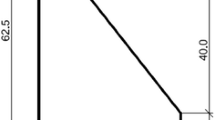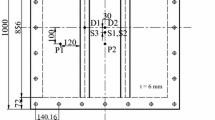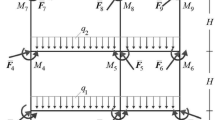Abstract
Some specific projects require that the structures being constructed are not anchored while being immersed. It is the case for recent bridges designed for large earthquake loadings, masonry structures, unanchored immersed storage structures. This solution gives more flexibility in the localization and in the use of such structures and a decrease in the internal stress. However, one has to evaluate precisely the behavior of this sliding structure, and in particular, the cumulative sliding displacement during a seismic event in order to prevent any impact or loss of stability. Given the highly non-linear behavior of such immersed sliding structures, the computational time and capacity to estimate the cumulative sliding displacement is important. It is then almost impossible to do easily a predimensioning of the structure or to apply a stochastic method in order to cover the possible time-history earthquakes corresponding to the dimensioning spectrum. The aim of this paper is to present a pseudo-analytical model to estimate the sliding amplitudes of different simplified systems which represent a given dynamic behavior: a single immersed sliding mass and an immersed sliding beam system. In each model, the fluid-structure interaction between the immersed body and the pool is modeled as hydrodynamic masses. The sliding is represented by a solid Coulomb friction. The seismic loading can be any 3D time-history accelerograms. The pseudo-analytical solutions are obtained considering the different phases of the movement and the continuity between each phase. The results are then compared to the values computed using \(ANSYS^{TM}\). The analytical curves show a good fit of the computational results. A comparison between 3 models is shown (single immersed sliding mass, immersed sliding mass-spring system, immersed sliding beam) stressing the importance of the model on the estimated sliding displacement.






Similar content being viewed by others
Notes
This assumption needs to be further analyzed with regard to the continuity or equivalence of the damping when changing the modal bases.
References
Antunes J, Axisa F, Beaufils B, Guilbaud D (1988) Coulomb friction modelling in numerical simulations of vibration and wear work rate of multispan tube bundles. In: Flow-induced vibration and noise, Winter annual meeting of ASME, vol 5
Appell P (1900) Sur l’integration des equations de mouvement d’un corps pesant de revolution roulant par une arrete circulaire sur un plan horizontal: cas particulier du cerceau. Rend Circ Mat Palermo 14:1–6
Appell P (1931) Traite de mecanique rationnelle. Gauthier-Villars, Paris
Ashar H, Degrassi G (1989) Design and analysis of free-standing spent-fuel racks in nuclear power (an overview), 10th. S.M.I.R.T, Los Angeles
Axisa F, Antunes J, Villard B (1988) Overview of numerical methods for predicting flow-induced vibrations. ASME J Press Vessel Technol 100:7–14
Betbeder-Matibet J, Pons JC, Labbe P, Noe H (1992) Seismic response of sliding structures and equipment. In: Recent advances in earthquake engineering and structural dynamics-Part V. Ouest Editions
Champomier F, Delemontey R, Sollogoub P, Toubas D (1989) Seismic design of a spent fuel storage rack, 10th. S.M.I.R.T, Los Angeles
Fritz RJ (1972) The effect of liquids on the dynamic motions of immersed solids. Trans ASME J Eng Ind 94:167–173
Gallop EG (1904) On the rise of a spinning top. Trans Camb Philos Soc 19:356–373
Godet M (1986) Modeling friction and wear phenomena. In: Proceeding of the workshop on the use of surface deformation models to predict tribology behaviour, approches to modelling of friction and wear, edition. Springer
Housner GW (1963) The behaviour of inverted pendulum structures during earthquakes. Bull Seismol Soc Am 2:403–417
Ishiyama Y (1980) Review and discussion on overturning of bodies by earthquake motions. BRI Research paper No. 85, Ministry of Construction, pp 1–115
Ishiyama Y (1982) Motions of rigid bodies and criteria for overturning by earthquake excitations. Earthq Eng Struct Dyn 10:635–650
Korteweg D (1900) Extrait d’une lettre M. Appell. Rend Circ Mat Palermo 14:7–8
Lewis AD, Rogers RJ (1988) Experimental and numerical study of forces during oblique impact. J Sound Vib 125:403–412
MacMillan WD (1936) Dynamics of rigid bodies. Dover Publications, New York
Makris N (2014) The role of the rotational inertia on the seismic resistance of free-standing rocking columns and articulated frames. Bull Seismol Soc Am 104(5):2226–2239
Makris N, Constantinou MC (1991a) Analysis of motion resisted by friction I. Contact Coulomb and linear/Coulomb friction. Mech Struct Mach 19(4):477–500
Makris N, Constantinou MC (1991b) Analysis of motion resisted by friction II. Velocity-dependent friction. Mech Struct Mach 19(4):501–526
Makris N, Konstantinidis D (2003) The rocking spectrum and the limitations of practical design methodologies. Earthq Eng Struct Dyn 32:265–289
Makris N, Vassiliou MF (2012) Sizing the slenderness of free-standing rocking columns to withstand earthquake shaking. Arch Appl Mech 82:1497–1511
Morand HJ-P, Ohayon R (1992) Interactions fluides-structures. Masson, Amsterdam
Mostaghel N, Tanbakuchi J (1983) Response of sliding structures to earthquake support motion. Earthq Eng Struct Dyn 11:729–748
Mostaghel N, Hejazi M, Tanbakuchi J (1983) Response of sliding structures to harmonic support motion. Earthq Eng Struct Dyn 11:355–366
Moudrik R (1996) Etude du comportement sismique d’un ratelier de stockage d’assemblages combustibles uses en piscine. These de doctorat, CEA
Othman MO, Elkholy AH (1994) Measurement of friction coefficient under reciprocating sliding conditions. Eur J Mech A Solids 13(2):215–225
Pena F, Prieto F, Lourenco PB (2007) On the dynamics of rocking motion of single rigid-block structures. Earthq Eng Struct Dyn 35:2383–2399
Pons JC (1986) Reponse dynamique d’une structure rigide sur fondation glissante, 1er Colloque National de Genie Parasismique, Saint-Remy-les-Chevreuses, 29, 39 et 31 janvier
Preumont A, Raymackersa A (1989) On the influence of the fluid on the seismic response of FBR Cores, 10th. S.M.I.R.T, Los Angeles
Prieto F, Lourenco PB (2005) On the rocking behaviour of rigid objects. Meccanica 40:121–133
Prieto F, Lourenco PB, Oliveira CS (2004) Impulsive Dirac-delta forces in the rocking motion. Earthq Eng Struct Dyn 33:839–857
Psycharis IN (1990) Dynamic behaviour of rocking two-block. Ph.D. thesis. University of Cambrdige
Ren M, Stabel J (1999) Comparison of different analytical formulations for FSI between fuel storage racks. In: Transactions on SMIRT-15
Routh EJ (1868) An elementary treatise on the dynamics of a system of rigid bodies. MacMillan, London
Routh EJ (1905) Advanced part of a treatise on the dynamics of a system of rigid bodies. MacMillan, London
Shannon CE (1949) Communication in the presence of noise. In: Proceedings of the institute of radio engineers, vol 37, no. 1, pp 10–21
Soler AI, Singh KP (1982) Dynamic coupling in a closely spaced two-body system vibrating in a liquid medium: the case of fuel racks. In: The 3rd Keswick international conference in nuclear plants
Stabel J, Ren M (2001) Fluid-structure-interaction for the analysis of the dynamics of fuel storage racks in the case of seismic loads. Nucl Eng Des 206:167–176
Stabel J, Rem M, Swelim H (1993a) Calculation of seismic loads on fuel storage racks under consideration of fluid-structure interaction, 12th. S.M.I.R.T, Los Angeles
Stabel J, Ren M, Swelim H (1993b) Calculation of seismic loads on fuel storage racks under consideration of fluid-structure interaction. In: Transactions on SMIRT-12
Stefanou I, Psycharis I, Georgopoulos I-O (2011a) Dynamic response of reinforced masonry columns in classical monuments. Construction and Building Materials
Stefanou I, Vardoulakis I, Mavraganis A (2011b) Dynamic motion of a conical frustum over a rough horizontal plane. Int J Non-linear Mech 46:114–124
Webster AG (1925) The dynamics of particles and of rigid, elastic and fluid bodies being lectures on mathematical physics, 2nd edn. B.G. Teubner, Leipzig
Westermo B, Udwadia F (1983) Periodic response of a sliding oscillator system to harmonic excitation. Earthq Eng Struct Dyn 11:135–146
Yim C, Chopra AK, Penzien J (1980) Rocking response of rigid blocks to earthquakes. Earthq Eng Struct Dyn 8:565–587
Zaghdoudi S (1992) Analyse des phenomenes d’usure par choc et frottement. These de doctorat de l’universite Paris VI
Author information
Authors and Affiliations
Corresponding author
Appendices
Appendix 1: Notation
1.1 Tensor notation
In this article, the tensor notation has been used. The dimension of each value is given by the number of underlines.
For example:
-
\(\underline{u} = (u_i)_{i \in [1, N]}\) is a 1-dimension vector where the basis is composed of N elements.
-
\(\underline{\underline{M}} = (m_{ij})_{i \in [1,N], j \in [1,M]}\) is a 2-dimension matrix with N lines and M columns.
1.2 Time and spatial derivatives
The time derivatives are noted with upper dots. The number of dots gives the order of the derivatives.
For example:
-
\(\dot{U} = \frac{\partial U}{\partial t}\): is a velocity,
-
\(\ddot{U} = \frac{\partial ^2 U}{\partial t^2}\): is an acceleration.
The Laplace operator is used in this article. It is used to simplify the notation. It depends on the coordinate system:
-
For a Cartesian system: \(\varDelta U = \frac{\partial ^2 U}{\partial x^2} + \frac{\partial ^2 U}{\partial y^2} + \frac{\partial ^2 U}{\partial z^2}\)
-
For a cylindrical system: \(\varDelta U = \frac{\partial ^2 U}{\partial r^2} + \frac{1}{r} \frac{\partial U}{\partial r} + \frac{1}{r^2} \frac{\partial ^2 U}{\partial \theta ^2} + \frac{\partial ^2 U}{\partial z^2}\)
Appendix 2: Fluid-structure coupling: Added mass
In this appendix, we will do a short summary of the governing equations and assumptions used for the added mass theory that models the fluid-structure coupling in the article. It will be illustrated using the example documented by Fritz (1972) of two concentric infinite cylinders with a perfect incompressible fluid annulus. Then, the generalized buoyancy theory will be developed.
2.1 Fluid-structure interaction: added mass theory
The fluid-structure coupling model presented in Sect. 2.4 is based on the added mass theory. This theory applies when the Froude and Stokes coefficients are important. It corresponds to a ‘perfect fluid’. Then, the hydrodynamic pressure in the fluid is given by:
where \(c_f\) is the velocity of sound in the water (1500 m/s), \(\varDelta\) is the Laplace operator and \(p_f\) is the hydrodynamic pressure in the fluid. At the fluid-structure interface, the structure is considered waterproof and since the fluid is modeled as a perfect fluid, there is no transverse friction. The interface conditions are:
where \(\underline{\underline{\sigma _s}}\) is the Cauchy internal stress of the structure, \(\underline{u_s}\) is the structure displacement, \(\underline{u_f}\) is the fluid displacement and \(\underline{n}\) is the fluid-structure interface surface vector.
These boundary conditions are usually expressed as:
where \(\rho _f\) is the fluid density.
Considering a virtual velocity \(\underline{\hat{V}_s} = \frac{\partial \underline{u_s}}{\partial t} \hat{Q}\) and using a frequency notation \(\underline{A}(t) = \underline{A_0} e^{i \omega t}\), one can express Newton’s second law for the structure as:
where \(\underline{\underline{M}}\), \(\underline{\underline{C}}\) and \(\underline{\underline{K}}\) are respectively the mass, damping and stiffness generalized matrix, \(\underline{q}\) is the generalized coordinate vector, \(\rho _f\) is the fluid density, \(\delta \Omega\) is the structure surface, \(S(q) = \frac{p}{\rho _f \omega ^2}\) is the hydrodynamic coupling surface and \(\underline{F_e}\) is the generalized external force.
It can then be demonstrated that the right element of equation (39), which is the fluid-structure coupling forces, is composed of:
-
a part proportional to the acceleration of the structure for the low frequencies,
-
a part proportional to the velocity of the structure for the middle frequencies,
-
a part proportional to the displacement of the structure for the high frequencies.
Since we are dealing with seismic loadings, the range of exciting frequencies is the low frequency. Then, the fluid-structure coupling is proportional to the acceleration of the structure. It can then be modeled as an added mass that is applied on the structure degree of freedom.
2.2 Example of analytical calculation of hydrodynamic added mass: 2 concentric infinite cylinder with a fluid annulus
This example is thoroughly described in Fritz (1972). For further explanation, the reader is advised to refer to this article. The studied configuration is presented in Fig. 7.
Where \(R_1\) and \(R_2\) are respectively the radius of the internal and external cylinders. We will consider only a displacement of the cylinders along the X-axis. The same demonstration is applicable for the Y-axis. \(U_{x,1}\) and \(U_{x,2}\) are respectively the displacements of the internal and external cylinders.
Using Eq. (35) and considering an incompressible fluid \((c \rightarrow \infty )\), we deduce the pressure equation in cylindrical coordinates:
The boundary conditions at the surface of each cylinder are:
where \(U_r (r=R_i) = U_{x,i} \cos \theta\) is the radial displacement at the surface of the cylinder i.
The pressure in the fluid is then calculated by solving Eq. (40) using the boundary conditions (41):
The fluid-structure interaction forces are obtained by projecting the fluid pressure on the surface of each cylinder. Considering a unit-length of cylinder, the force applied on cylinder i is:
The fluid-structure interaction forces applied on the internal and external cylinders are null along the Y-axis. The forces along the X-axis are expressed as:
where:
-
\(M_1 = \rho _f \pi R_1^2\): is the equivalent mass of water occupied by the internal cylinder per unit length,
-
\(M_2 = \rho _f \pi R_2^2\): is the equivalent mass of water stored in the external cylinder per unit length,
-
\(M_H = M_1 \frac{R_2^2 + R_1^2}{R_2^2 - R_1^2}\): is the hydrodynamic mass per unit length.
\(M_1\) and \(M_2\) are directly linked to the generalized buoyancy effect presented in Appendix 2. \(M_H\) is the mass involved in the fluid-structure interaction when the two cylinders have different accelerations and is called hydrodynamic mass.
The expressions obtained in Eqs. (45) and (46) can be generalized to more complex systems as the ones developed in this article.
2.3 Fluid-structure interaction: generalized buoyancy
When an immersed structure is subjected to an earthquake loading, the local coordinate system is no longer a Galilean system. In this local coordinate system, the ground motion creates an acceleration field that is applied to the structure. This horizontal acceleration field also creates an horizontal buoyancy: the ’generalized buoyancy’.
To illustrate this phenomenon, let us consider an unidirectional ground motion \(U_{g} (t)\) that is applied on two structures A and B. The motion of the structures is expressed using the vector \(\underline{U_{gal}} (t) = \left( U_{A,gal} (t), U_{B,gal} (t) \right)\) in the Galilean system and \(\underline{U_{l}} (t) = \left( U_{A,l} (t), U_{B,l} (t) \right)\) in the local system. We obtain:
The governing equation is in the Galilean system:
Four terms are linked to the ground displacement:
-
\(\underline{\underline{M}}.\left( \begin{array}{l} \ddot{U}_g (t) \\ \ddot{U}_g (t) \end{array}\right)\): corresponds to the seismic inertial force. It is the usual seismic loading.
-
\(\underline{\underline{C}}.\left( \begin{array}{l} \dot{U}_g (t) \\ \dot{U}_g (t) \end{array}\right)\): corresponds to a seismic damping force. It is null when the damping is produced by actual dampers.
-
\(\underline{\underline{K}}.\left( \begin{array}{l} U_g (t) \\ U_g (t) \end{array}\right)\): corresponds to a seismic elastic force. It is null when the stiffness matrix is constituted from actual springs.
-
\(\left( \begin{array}{ll} M_A &{} M_{AB} \\ M_{AB} &{} M_B \end{array}\right) . \left( \begin{array}{l} \ddot{U}_g (t) \\ \ddot{U}_g (t) \end{array}\right) = \left( \begin{array}{l} M_A^1 \ddot{U}_g (t) \\ M_B^1 \ddot{U}_g (t) \end{array}\right)\): corresponds to the generalized buoyancy. It is applied on each individual structure considering an equivalent ’displaced water mass’ \(M_A^1 = M_A + M_{AB}\) for structure A and \(M_B^1 = M_B + M_{AB}\) for structure B. This displaced water mass is implemented in a generalized buoyancy matrix \(\underline{\underline{M_1}}\).
For the configuration considered in 1, the fluid structure interaction matrix corresponds to \(M_A = -M_H\), \(M_{AB} = M_H + M_1\) and \(M_B = - (M_H + M_1 + M_2)\). In this case, \(M_A^1 = M_1\) which corresponds to the equivalent water mass displaced by the internal cylinder and \(M_B^1 = M_2\) which corresponds to the equivalent water mass contained in the external cylinder. These two masses corresponds to the classical masses considered for the vertical buoyancy effect but applied to an horizontal acceleration field (the earthquake loading).
For classical structures, a reformulation of the governing equations for the fluid-structure interaction of structure submitted to earthquake loadings is:
where \(\underline{\underline{M_H}} = - \left( \begin{array}{ll} M_A &{} M_{AB} \\ M_{AB} &{} M_B \end{array}\right)\) is the hydrodynamic coupling mass matrix, \(\underline{\underline{M_1}} = \left( \begin{array}{ll} M_A^1 &{} 0 \\ 0 &{} M_B^1 \end{array}\right)\) is the generalized buoyancy mass matrix, \(\underline{U} (t) = \underline{U_{l}} (t)\) is the local structural displacement and \(\underline{U_e} (t) = \underline{U_g} (t)\) is the ground displacement. Equation (49) is the equation that is used in this article in its generalized form.
Rights and permissions
About this article
Cite this article
Mege, R. Pseudo-analytical model for sliding immersed structures under time-history earthquake loadings. Bull Earthquake Eng 15, 1297–1318 (2017). https://doi.org/10.1007/s10518-016-9990-8
Received:
Accepted:
Published:
Issue Date:
DOI: https://doi.org/10.1007/s10518-016-9990-8





